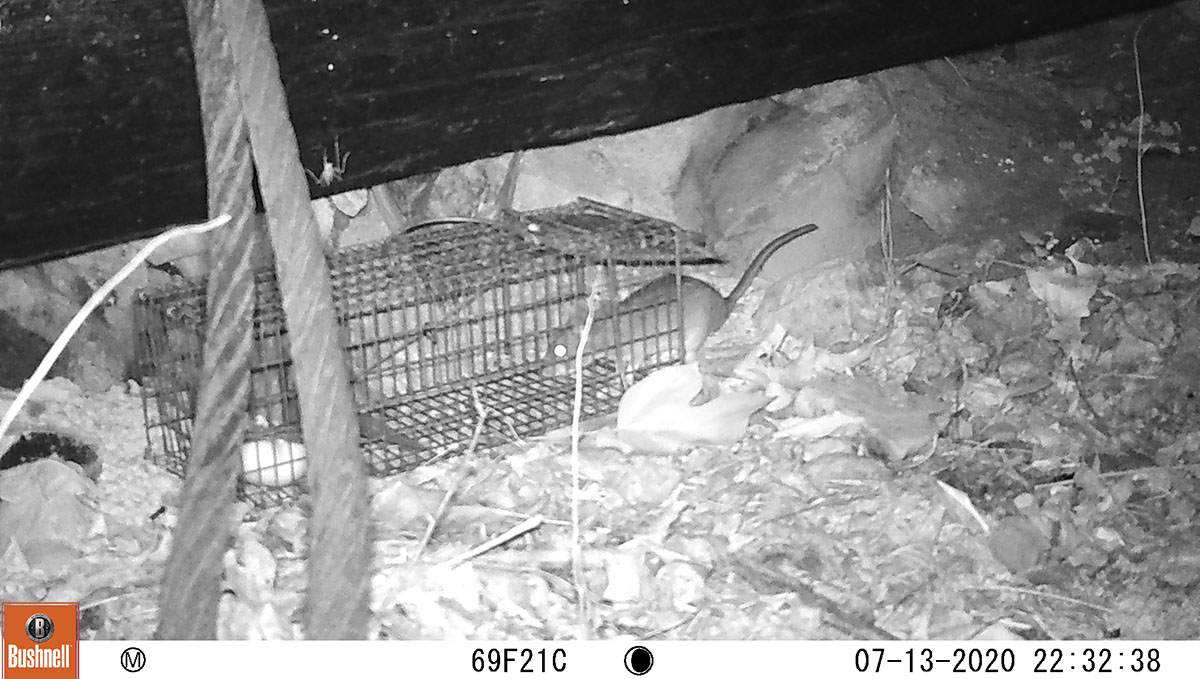By Bruce Ingram
Rick Reynolds often spends part of his week striving to make sure that more “rats” roam the Old Dominion. Before you erupt in rage about a state employee assisting vermin, please consider that this Virginia Department of Wildlife Resources (DWR) non-game biologist’s work is an important aspect of supporting all manner of Virginia’s wildlife. The Allegheny woodrat is native to our state and a significant part of the ecosystem, as compared to the invasive, and, rightfully scorned, Norway rat.
“On a basic level, everything that has to do with wildlife is habitat-oriented,” Reynolds said. “There is much overlap between non-game and game animals’ habitats, and any work we biologists do to help out a non-game species will also likely be beneficial to many species of game and other non-game species.”
The Allegheny woodrat is currently the focus of much of Reynolds’ energy. This woodrat (Neotoma magister) is a member of the pack rat family, and its problems began in the early 20th century with the American chestnut blight that devastated one of the rodent’s major food sources. Oak decline, which is occurring now, has made the situation worse, according to Reynolds. Of course, the waning of two major hard mast food sources has not only negatively impacted the woodrat, but also other game and non-game animals.

An Allegheny woodrat entering a live-trap and captured on wildlife camera in Rockbridge County. Photo by Rick Reynolds DWR.
A second factor, continued the biologist, has been habitat loss and fragmentation. The woodrat favors rocky outcrops, talus slopes, caves, boulder fields, and similar rocky terrain. When development causes these types of habitats to become fragmented (think roads and subdivisions), woodrat populations can become isolated over time and even possibly disappear.
Yet another perpetrator is a roundworm parasite that thrives within raccoons. With its pack rat tendencies, the Allegheny species often picks up coon scat and brings the poop back to its nest where the creature consumes the undigested seeds. All these issues have caused this native woodrat to become listed as a Species of Greatest Conservation Need in Virginia’s Wildlife Action Plan.
Reynolds says that relatively speaking, Virginia, West Virginia, Tennessee, and Kentucky are the current strongholds of the woodrat, with the upper Northeast states at the heart of the decline. As a result, Pennsylvania is now creating artificial structure, such as boulder fields, with the objective of providing cover habitat between known populations. Some states are even actually treating raccoons for the roundworm parasite by creating bait piles infused with antibiotics.
Reynolds believes that habitat improvement projects that promote oaks and acorn production could be beneficial to the woodrat, as would the re-establishment of the American chestnut. The good news is that the commonwealth still possesses a sufficient amount of rocky habitat of the right kind. Coupled with that fact is that much of this type of environment exists in Virginia’s George Washington and Jefferson National Forest as well as U.S. Park Service land, DWR Wildlife Management Areas (WMA), and on holdings of other conservation partners in the Virginia mountains.

Woodrat captured at Harpers Ferry in summer 2022. Photo by Rick Reynolds/DWR
Of course, continued Reynolds, habitat protection/management activities targeted for the Allegheny woodrat also help many other species utilizing rocky outcrops, including bats (small-footed and big brown, for example), plus the long-tailed weasel, spotted skunk, and others. And Reynolds himself is busy with projects involving numerous bat species (Rafinesque’s big-eared, Virginia big-eared, tree bats, northern long-eared, tri-colored, and little brown) as well as the water shrew, rock vole, spotted skunk, and weasel species.
So with tax time approaching, now is a prime time to donate to the Department of Wildlife Resources’ (DWR) non-game wildlife fund. If you have a state tax refund coming, you can designate any portion or all of your tax refund to support the management of non-game wildlife in Virginia. If you do not want to wait until tax time, you can donate directly to the program by sending a check directly to: Virginia Department of Wildlife Resources, Virginia’s Non-Game Program, P.O. Box 90778, Henrico, VA 23228-0778, or you can make a donation online. You’ll get a receipt for your donation, which you can claim on your next year’s federal and state tax returns.


